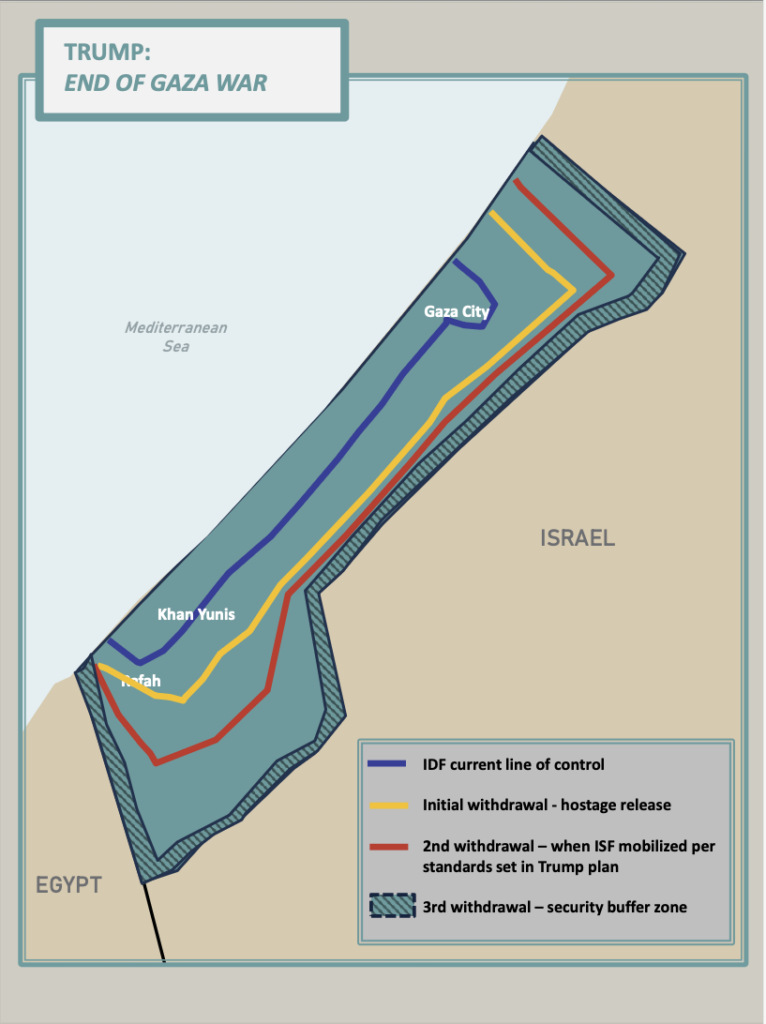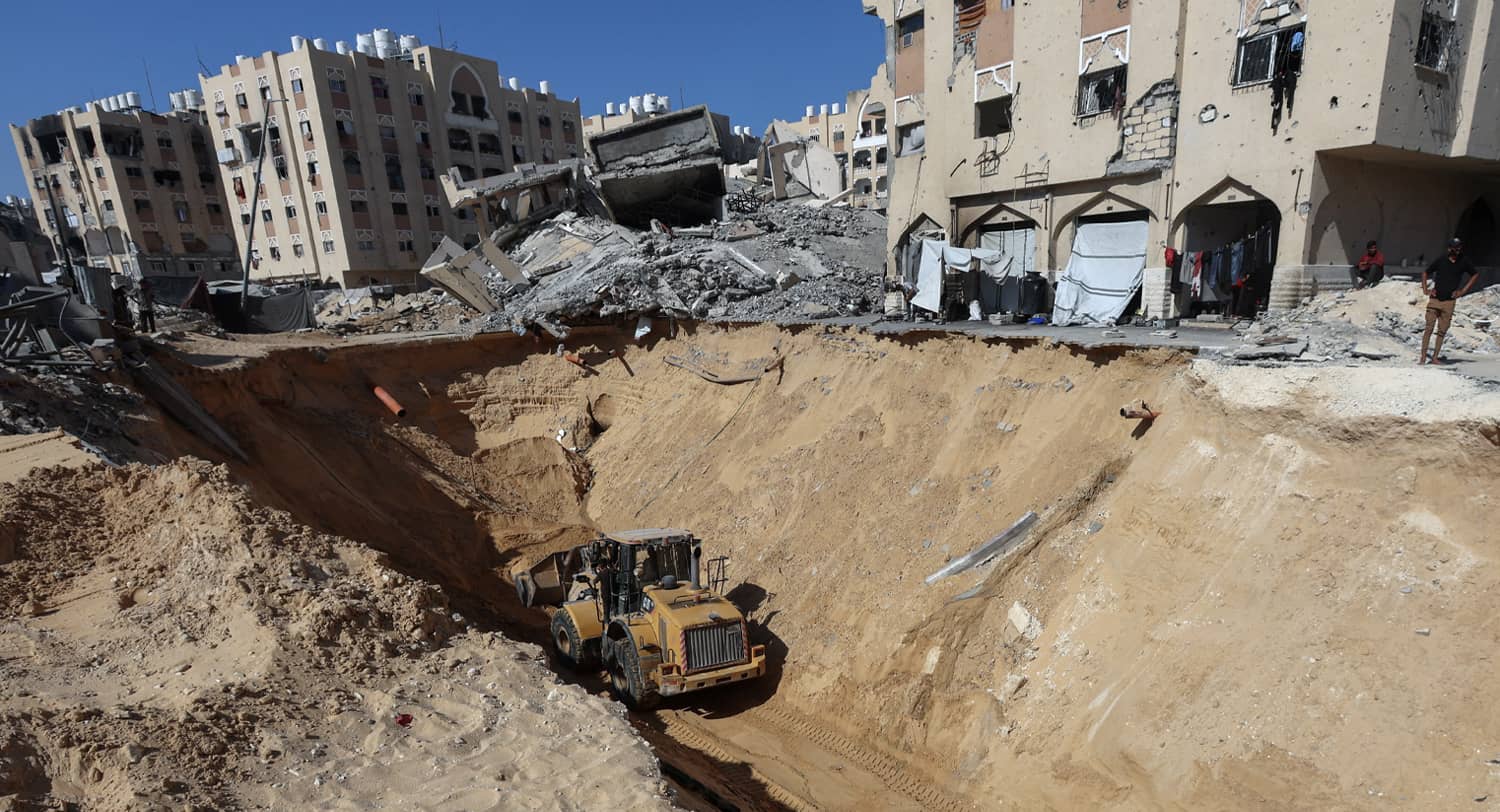It was a holiday like no other in recent memory. On the eve of Simhat Torah 2025, exactly two years on the Jewish calendar to the day of the Hamas attack in 2023, the 20 remaining live hostages were released to ambulances. Watching from a respectful distance, Israeli crowds on the Gaza border cheered. Later that day, President Trump arrived in Israel and spoke to the nation from the Knesset podium. Israel, Hamas and the main regional states had all agreed to his 20-point Gaza Peace Plan.
That night, in my neighborhood synagogue in Jerusalem and, I suspect, throughout the country, Israelis both secular and religious alike sang and danced with the Torah, celebrating the annual conclusion of its public reading and this once in a lifetime joyous occasion. Now, a week later, as the national mood of elation begins to fade, let’s pause to recall that we live in historic days when miracles of redemption are real, witnessed collectively by whole nations.
How did Trump and team pull off this Gaza Peace Plan, and where is it headed from here?
The Deal
The full story of the negotiations, with all the juicy details, will have to await the future memoirs of Trump himself, since he personally led much of the talks with Prime Minister Netanyahu and then with regional leaders. But three points seem clear.
First, the 20-point plan met all of Israel’s war objectives, as Prime Minister Netanyahu has publicly declared.
Israel would get back all of the hostages, alive and dead, within 72 hours of its agreement to the deal, while withdrawing to a position inside Gaza that retains Israeli control of all the border crossing points into Gaza, including Rafah on the southern border with Egypt. In exchange, Israel would release 250 Palestinian prisoners convicted of terrorist crimes in Israel and another 1,700 Gazans detained since the start of the war on October 7, 2023.
Gaza would undergo a “process of demilitarization under the supervision of independent monitors” with Hamas and other militant groups surrendering their weapons.
Hamas would also surrender governance to a “temporary transitional” committee composed of “qualified Palestinians and international experts” with oversight from a Board of Peace chaired by President Trump (including other heads of state) and supported by a temporary International Stabilization Force that would deploy to Gaza and begin training a Palestinian police force.
The Israel Defense Forces (IDF) would begin to withdraw from its positions inside Gaza and hand over control of territory to the International Stabilization Force as it establishes stability and based on milestones linked to Hamas demilitarization, leaving the IDF in a security perimeter inside Gaza “until Gaza is properly secure from any resurgent terror threat.”
Finally, neither the 20-point plan nor its global endorsement in the Sharm al-Sheikh declaration (signed by both Qatar and Turkey) calls for a Palestinian state. Instead there is conditional language in the plan that “conditions may finally be in place for a credible pathway to Palestinian statehood” once Gaza is reconstructed and after the Palestinian Authority reform “is faithfully carried out.”
Netanyahu could not have measurably improved on these terms had he instead rejected them and continued the IDF operation of retaking all of Gaza City. That alternative would have carried its own risks, including further Israeli casualties and continuing loss of international goodwill, and would have saddled Israel with sole responsibility for more than two million Gazan civilians.
So second, the question is not why Netanyahu agreed to the Trump plan but rather why Hamas agreed to it, especially agreeing to give up the hostages, its sole leverage against Israel? Herein lies the major innovation of Trump and team. They have the good sense, perhaps learned from years of sharp-edged business dealings, of understanding the other side’s weaknesses.
Palestinian leaders, both the PLO and Hamas, have always required intensive outside support simply to survive. This comes traditionally from Egypt, the Gulf and more recently Turkey (and previously from the Soviet Union in the case of the PLO). What Trump did – which no other US negotiator had even tried to do – was secure the prior agreement of Palestinians’ outside patrons (in Hamas’s case, Qatar and Turkey).
The main negotiation focus, with Netanyahu on board, was Qatar, which got a pre-arranged apology from Netanyahu (for his airstrike on Hamas headquarters in Doha that killed a Qatari security guard) and a US security guarantee in the form of an executive order. Turkey seems to have gotten a soft promise to be approved to purchase the F-35 stealth fighter plus benefits to be named later. With its patrons already in agreement with the Trump deal, Hamas had nowhere to hide.
One might ask: why didn’t the Biden team try to do this? For that matter, why didn’t President Clinton and team similarly try to gain the support first of the PLO’s outside support before convening the Palestinians and Israelis at Camp David in the year 2000, leading to the Clinton parameters for peace (which an Israeli government accepted but Arafat’s PLO rejected)?
There are several possible explanations, including the Washington peace processors’ predilection to focus pressure for concessions on Israel, which has a certain logic given that Israel has the closer relationship with the US and the most to give.
However, I think the real answer is that Trump’s targeted demonstration of force in the region, in particular the June 22 B-2 bombing of Iran’s nuclear facilities, put the US in a commanding position. The only equivalent time of regional influence I can recall was following the First Gulf War in February 1991 when George H.W. Bush led a coalition to liberate Kuwait. Other presidents lacked that level of influence, either with the traditional patrons of the Palestinians or with Israel. In short, a combination of willingness to use targeted force at the right time and the ability to offer incentives got all the parties on board an impressive plan that forced a ceasefire and laid the groundwork for reconstruction of Gaza.
There is a third take-away: Hamas is a terrorist group and doesn’t honor deals. Once the IDF withdrew from Gaza City, Hamas released the 20 live hostages but has been dribbling out the dead bodies of hostages by twos and threes (many of them were killed on October 7, 2023 and their bodies taken into Gaza for future trading leverage).
Hamas states it will not disarm or agree to a demilitarization process. Instead it now calls the Trump plan a “hudna” or truce (a likely reference to the Hudeibiyah truce that the Prophet Muhammad entered into with his tribal rivals, a truce that can be broken at any time). Indeed Hamas on October 19 shot an anti-tank missile at the repositioned IDF forces, killing two Israeli soldiers and triggering an Israeli retaliation.
“Israel Violates Ceasefire” ran a Guardian headline on October 19, without mentioning the prior Hamas missile strike or that Hamas has declared it won’t allow a demilitarization process, as required by the plan it agreed to. One weapon remaining in Hamas arsenal is the support of some international news media complemented by their supporters’ voluminous social media, where they pushed out a flood of anti-Israel messages immediately after the Trump Peace Plan was announced.

The Beginning of Postwar Gaza Reconstruction
The American political elite has been forced to recognize the achievement of the Trump peace plan; the most graceful recognition came from former Secretary of State Hilary Clinton who had personally invested considerable political capital in the Israeli-Palestinian project and thus appreciates the Trump achievement.
But with Hamas doubling down on its control over roughly half of Gaza, including through street executions of potential rivals, the pundits are proclaiming that the plan is fragile and likely to fail. That prediction is flawed for two main reasons.
First, Israel remains in control of all border crossings into Gaza. The amount and kinds of weapons that Bedouin smugglers in Sinai can fly into Gaza via drone is limited. Furthermore, while Israel is allowing in humanitarian supplies, it can prevent cement and other reconstruction materials into the Hamas-controlled parts of Gaza.
Second, it appears that the transitional governance and reconstruction parts of the Trump plan will soon begin in the 53 percent of Gaza under Israeli control, which once in place will allow for gradual IDF withdrawal. One initial sign of progress is the deployment of a “civil-military operations center” from the regional US military command in the Middle East, Central Command. These 200 US soldiers are based just outside of Gaza in Israel, starting the necessary coordination work leading eventually to staged IDF withdrawal in favor of the International Stabilization Force (ISF).
Which countries will send troops to the ISF? To date, there are only rumors, but it appears that the US is working with a combination of regional countries (Egypt in particular) and others (including Indonesia, Azerbaijan and Italy, the last having well trained and equipped military police forces, the Carabinieri).
In short, the prospects of success in postwar Gaza of the team that delivered the Trump Peace Plan should not be discounted.
Nor should the future prospects for Gaza’s reconstruction. Its residents are resilient and sitting on a traditional international trade crossroads, which for millennia was the main port in the southern Levant. If the Trump team succeeds, those days could return sooner than many appear to think.



